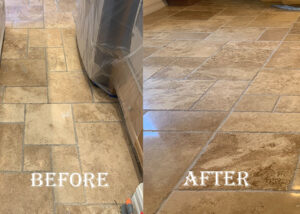Travertine Floor Restoration Los Angeles: Revive Your Natural Stone Beauty
Travertine floors bring a timeless elegance to any home, but daily wear and tear can leave them dull, scratched, and lifeless.
JK Marble Maintenance specializes in professional travertine floor restoration services in Los Angeles, restoring your stone’s natural beauty and shine. We serve homeowners and businesses throughout the greater Los Angeles area, including Beverly Hills, Calabasas, Encino, Studio City, West Hollywood, Pacific Palisades, and surrounding communities.
We serve homeowners and businesses throughout the greater Los Angeles area, including Beverly Hills, Calabasas, Encino, Studio City, West Hollywood, Pacific Palisades, and surrounding communities.
Our Travertine Floor Restoration Process
We utilize a proven process to deliver exceptional travertine floor restoration results:
Inspection and Assessment: We thoroughly inspect your travertine floors to assess their condition and determine the best course of action.
Cleaning: We deep clean your travertine to remove dirt, grime, and any existing sealers.
Honing: This process uses abrasive pads to remove scratches, etches, and other imperfections, creating a smooth, even surface. We offer various levels of honing to achieve the desired finish, from a matte to a satin appearance.
Polishing (Optional): If you desire a high-gloss shine, we can polish your travertine floors to a mirror-like finish. We also offer a lower-sheen polish for a more subtle elegance.
Sealing: We apply a high-quality sealant to protect your travertine floors from stains, water damage, and future wear.
Benefits of Professional Travertine Floor Restoration
- Enhanced Beauty: Restore your travertine floors’ natural color, veining, and shine.
- Increased Value: Well-maintained travertine floors can significantly increase the value of your property.
- Extended Lifespan: Regular restoration and maintenance can prolong the life of your travertine floors.
- Improved Hygiene: Professional cleaning and sealing help to remove bacteria and allergens.
Why Choose JK Marble Maintenance for Your Travertine Floors?
- Experienced Technicians: Our team has extensive experience in travertine floor restoration and uses the latest techniques and equipment.
- Quality Workmanship: We are committed to providing exceptional results and exceeding our clients’ expectations.
- Competitive Pricing: We offer competitive pricing and free estimates.
- Local Expertise: We are a locally owned and operated business serving the Los Angeles community.
Service Areas
We proudly serve the following areas in Los Angeles:
- Beverly Hills
- Calabasas
- Encino
- Studio City
- West Hollywood
- Pacific Palisades
- And surrounding Los Angeles communities
Call to Action:
Ready to restore the beauty of your travertine floors? Contact JK Marble Maintenance today for a free estimate! 818 984-1195 | [email protected]|
.

